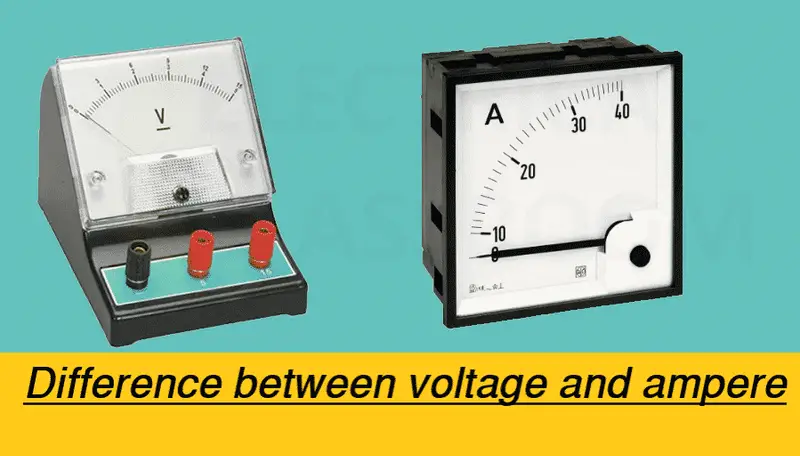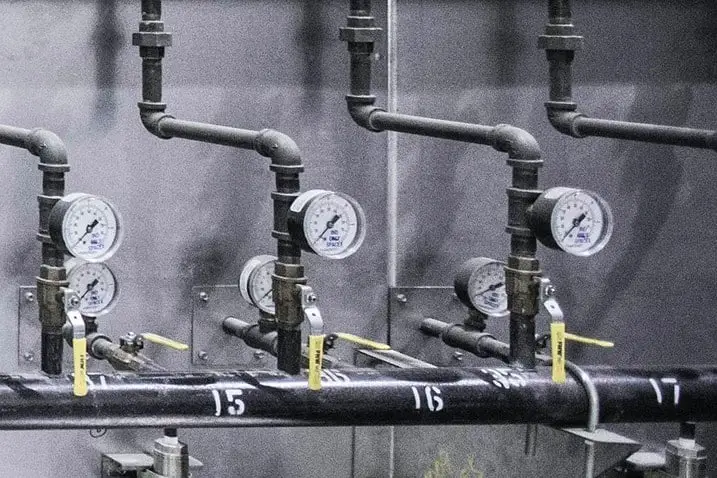Volts and amps or ampere are two measures of electricity. Specifically, voltage is the measure of electric potential difference between two points whereas ampere is the measure of electric current. They are closely related terms and can be a bit difficult to understand. In this article, let’s learn the difference between volts and amps.

What is a volt?
Volt is the unit for electric potential difference or electromotive force. The electric potential difference can be considered as a force that drives electrons to pass through a conductor. If you connect the leads of a voltmeter, one to the positive and the other two to the negative of a battery, what the voltmeter reads is called electric potential difference or Voltage. The unit of voltage is Volts.
What is Amps or Amperes?
Ampere or shortly known as Amps is the unit of electric current. In the above paragraph, you might have read that the voltage drives electrons through a conductor. This flow of electrons caused by the potential difference is known as an electric current. It is measured in amperes.
Difference between volts and amps explained using water-pipe analogy
In the above picture you can see there smaller pipes connected to a larger pipe. As you know there should be sufficient pressure in the large pipe to lift water up the smaller pipe. Higher the pressure in the large pipe more water flows out through the smaller pipe. In addition to, the diameter of smaller pipes also determines the water flow. Here,
Large pipe – Can be compared to a battery in a circuit.
Smaller pipe – wires connected to a battery.
Pressure – Can be compared to voltage.
Water – Charges or electrons that constitutes the current flow.
Water flow in each smaller pipes – Can be compared to current.
Rate of current flow – Amperes
Hope this analogy has made volts vs amps more clear to you. Now, let’s compare them side by side and understand the difference between volts and amps better.
Volts vs amps
| Properties | Volts | Amps |
|---|---|---|
| Definition | Unit of measure of electric potential difference or voltage. | Unit of measure of electric current through a conductor. |
| Analogy | Voltage can be compared to the pressure of water stored in large pipe (refer above analogy). | Ampere can be compared to the rate or speed at which water flows through each of the smaller pipes. |
| Formula | Joule / coulomb | Coulomb / second |
| Point of measurement | Voltage is measure between any two point in a circuit. | Current can measure at any point in a circuit. It is basically the number of electrons passing a point per second. |
| Measurement device | Voltmeter | Ammeter |
| Notation | Volts is denoted by ‘V’. | Ampere is denoted by ‘A’. |
Volts vs amps: Key points to remember.
- Volts refers to the difference in electric potential buildup by an accumulation of charges at a point with reference to another point.
- Ampere or amps refers to the number of charges passing any point in a circuit.
- One volt is defined as the electric potential between two points when one joule of work is done in moving one coulomb of charges from one of the points to the other.
- One ampere is equal to one coulomb of charge passing a point in a second.
Summary
Volts represent the measure of potential difference between any two points in an electric field whereas ampere is the rate of current flow in a conductor or a circuit. Hope that the above explanations and analogy has helped you understand the difference between volts and amps or ampere.

For a very long time this unknown has been a thorn in my mind. I thought I may have figured it out, using a speed versus acceleration analogy for comparison. Kind of close it turns out, so if I’m understanding the analogy correctly, force and speed would be closer. Best explanation I seen yet, thanks.
Thank you!
so what does this all mean?
if volts are like pressure then what is the maximum amount of volts that a wire can handle?
The wires themselves does not have an upper limit. It’s the insulation has a breakdown voltage.
hmm wires can burn if the voltage is too high
Thank you so much for
Great explanation. Very helpful. Thank you!
Well that was as clear as mud , I didn’t understand a word of it. There must be an easy explanation?????
Easy way to understand is: think of water coming out of a garden hose. The amount of water is electric current and pressure is voltage.
That was a really nice way of putting it! 🙂
Trying to look at this from 3 points of view: The BATTERY, the CHARGER -and- the DEVICE/TOOL. To start with all the items are 20V. But the CHARGER claims it charges different available BATTERIES at, 40 min. (1.5 Ah battery), 70 min. (3.0 Ah battery), 125 min. (5.0 Ah battery). If the CHARGER is trying to get all 3 to the same “Pressure” (20Volts), than the only difference is the “speed” of the current. So if the 1.5 Ah is the slowest current, why is it the fastest charging to the same pressure of 20Volts? Seems like the faster 5.0 Ah current would charger faster. Please advise…
3 Point Analogy:
> WATTS are the Lake or Pond of water. The more WATTS the large the body of water, and it determines the amount available. This could be the size of a rechargeable Battery; the bigger ones offer more internal wiring and other materials that create more amount of charge. Or the amount of AC the Electric Company is sending down the Main Lines to the transformers at your house.
> VOLTS are the Hole in the dam that is holding the water back. A small 1inch hole won’t let the water escape w/ too much Pressure but a 5 inch hole could squirt hard enough to knock you down.
> AMPS is the size of the pipe connected to the hole allowing the speed of the Current or Flow of water. Even though the hole in the dam maybe be 5 inches wide, connecting a 1 inch pipe (w/ a reducer) would force the water to flow slower than if connecting w/ a 4 or 5 inch pipe. But w/ the higher potential pressure that the 5 inch hole offers.
The 1.5 Amp battery charges the fastest because it has the least amount of “space” to fill with electricity. I will introduce Watts (a unit of power) to help visualize the storage of the batteries. Watts is equal to Volts times Amps (V * A = P) and is used to define how much electricity is travelling through a wire. Watts can also be multiplied by time to give the energy (storage) of a battery (P * T = E). Now, back to the example. Since you didn’t provide the amperage of the charger, let’s assume that it has an amperage of 1.5 Amps. Assuming all of the batteries and the charger are rated at 20V, the 1.5 Amp battery and the 1.5 Amp charger both have a power of 30 Watts, and after being charged for 40 minutes the battery has 1200 units of energy. Now the 3 Amp battery rated at 20V has a power of 60 Watts, and after being charged for 70 minutes has 2100 units of energy. But isn’t it supposed to be 4200 units of energy because it’s 60W times 70 Min? Well no because your still using the same 1.5 Amp charger on a 3 Amp battery. Let’s picture each amp as a separate pathway for electrons to travel down. the 1.5 Amp battery charged in 40 min with the 1.5 Amp charger, and every available “pathway” was used up by the charger. Now if you try to charge the 3 Amp battery with the same 1.5 Amp charger, you now have 1.5 “pathways” of electricity empty because the charger can’t utilize them. This in turn causes the charger to take longer to get the battery to full, even though they both have the same Volts. If you where to charge the 3 Amp battery with a 3Amp charger, then it would only take 40 minutes because the charger is able to use up every “pathway” that the battery has open. Same for the 5 Amp battery. However, if you tried to use more volts to charge the battery at a higher amperage, let’s say a 40V and 1.5 Amp charger for the 20V and 3 Amp battery, it would result in an exploded and useless battery. This is because your now trying to jam electrons at a greater speed than the battery was meant to take, and the resulting heat generated often causes an explosion to happen. Hope this helped with your question!
Great article, really good discussion. Andrey K.’s summary example brought it home for me, thank you all!